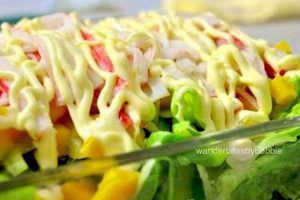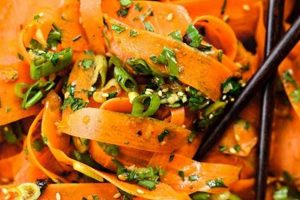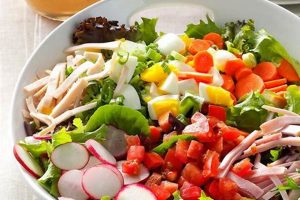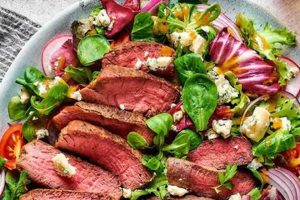A plant-based dish centered around quinoa, this culinary creation typically incorporates a variety of vegetables, legumes, herbs, and a flavorful dressing. Examples include combinations such as roasted sweet potatoes and black beans with a lime-cilantro vinaigrette, or Mediterranean-inspired versions with cucumbers, tomatoes, olives, and a lemon-herb dressing. The versatility of quinoa allows for diverse flavor profiles and ingredient combinations.
This type of dish offers a nutritious and satisfying meal option. Quinoa, a complete protein source, provides essential amino acids, fiber, and minerals. Combined with fresh produce and legumes, the dish becomes a powerhouse of nutrients, supporting overall health and well-being. Its adaptability to diverse dietary needs and preferences makes it a popular choice for those seeking plant-based meals. Furthermore, the increasing awareness of sustainable food practices has contributed to the growing popularity of quinoa as a grain crop.
The following sections will delve into specific ingredient selections, preparation methods, and creative variations for crafting delicious and nutritious plant-based meals featuring quinoa.
Tips for Creating Delicious Plant-Based Quinoa Salads
Achieving optimal flavor and texture requires careful consideration of ingredient selection and preparation techniques. The following tips offer guidance for crafting exceptional plant-based quinoa salads.
Tip 1: Rinse the quinoa. Rinsing quinoa before cooking removes saponins, a natural coating that can impart a bitter flavor. Place quinoa in a fine-mesh sieve and rinse thoroughly under cold water until the water runs clear.
Tip 2: Toast the quinoa (optional). Toasting quinoa before cooking enhances its nutty flavor. Heat a dry skillet over medium heat and add the rinsed quinoa. Toast, stirring frequently, until fragrant and lightly golden.
Tip 3: Select a variety of colorful vegetables. Incorporating a diverse range of vegetables provides visual appeal, textural contrast, and a broader spectrum of nutrients. Consider using roasted sweet potatoes, bell peppers, or raw chopped cucumbers and tomatoes.
Tip 4: Add legumes for protein and texture. Legumes such as black beans, chickpeas, or lentils complement quinoa’s nutritional profile and contribute a satisfying heartiness to the salad.
Tip 5: Enhance the flavor with fresh herbs. Fresh herbs like cilantro, parsley, mint, or dill brighten the flavor profile. Add herbs generously just before serving to maximize their aroma and taste.
Tip 6: Create a vibrant dressing. A well-balanced dressing elevates the overall flavor of the salad. Experiment with different combinations of citrus juices, vinegars, oils, and spices.
Tip 7: Don’t overcook the quinoa. Overcooked quinoa becomes mushy. Cook according to package directions, typically using a 1:2 ratio of quinoa to water or broth.
Tip 8: Allow the salad to cool slightly before serving. This allows the flavors to meld and enhances the overall enjoyment of the dish.
By following these tips, one can consistently produce flavorful, nutritious, and visually appealing plant-based quinoa salads.
The following section will explore specific recipe variations and offer further inspiration for incorporating these dishes into a healthy and balanced diet.
1. Ingredient Selection
Ingredient selection forms the foundation of a successful vegan quinoa salad. The choice of components directly impacts the nutritional value, flavor profile, and overall appeal of the dish. Careful consideration of each ingredient’s contribution is essential. A well-composed salad might include cooked quinoa as the base, combined with roasted root vegetables for sweetness and depth, leafy greens for freshness and vitamins, legumes for added protein and texture, and nuts or seeds for healthy fats and crunch. For example, roasted sweet potatoes and Brussels sprouts provide contrasting textures and sweetness, while chickpeas offer a creamy counterpoint and a boost of protein.
The synergy between ingredients creates a complex flavor profile. Balancing contrasting tastes and textures is crucial. The acidity of a citrus vinaigrette complements the earthiness of roasted vegetables, while the bitterness of kale can be offset by the sweetness of dried cranberries. A variety of textures, from the soft quinoa to the crisp vegetables and crunchy nuts, adds interest and prevents monotony. Consider the interplay between roasted beets, toasted pecans, and a lemon-tahini dressing, where the earthy beets, nutty pecans, and tangy dressing create a harmonious blend of flavors and textures.
Strategic ingredient selection elevates a simple quinoa salad to a culinary experience. The dish becomes more than the sum of its parts. Nutrient density, flavor complexity, and textural variety contribute to a satisfying and healthful meal. Understanding the role of each ingredient allows for informed choices that optimize both nutritional value and culinary appeal. This knowledge empowers individuals to create balanced and delicious vegan quinoa salads tailored to individual preferences and dietary needs.
2. Flavor Balance
Flavor balance is paramount in a successful vegan quinoa salad. The absence of animal products necessitates a nuanced approach to achieving a harmonious and satisfying taste profile. Balancing contrasting flavorssweet, sour, salty, bitter, and umamicreates complexity and depth. A well-balanced salad avoids monotony and engages the palate fully. For example, the inherent nuttiness of quinoa can be complemented by the sweetness of roasted vegetables like butternut squash or sweet potato. The addition of a tangy vinaigrette, perhaps incorporating citrus juice or vinegar, provides acidity, while a sprinkle of toasted nuts or seeds adds a touch of bitterness and desirable texture.
Careful consideration of individual ingredients and their interaction is essential. Each component contributes to the overall flavor profile. The bitterness of kale can be balanced by the sweetness of dried cranberries or a light maple syrup drizzle in the dressing. The earthiness of mushrooms benefits from the brightness of fresh herbs like parsley or dill. A creamy avocado can provide richness and a smooth counterpoint to crunchy vegetables like bell peppers or cucumbers. Understanding these interactions allows for the creation of a multi-dimensional flavor experience. A salad composed of roasted broccoli, toasted almonds, dried cranberries, and a lemon-tahini dressing demonstrates the interplay of bitterness, nuttiness, sweetness, and acidity.
Achieving flavor balance requires both culinary intuition and a willingness to experiment. It is a dynamic process influenced by individual preferences and ingredient availability. However, the fundamental principles remain consistent: contrasting flavors create complexity and prevent any single taste from dominating. The result is a vibrant and satisfying culinary experience that showcases the versatility and potential of plant-based cuisine. Mastering this aspect of vegan cooking elevates a simple quinoa salad from a basic dish to a sophisticated and flavorful meal.
3. Textural Variety
Textural variety is a critical element in a successful vegan quinoa salad, elevating it from a simple dish to a culinary experience. A combination of textures enhances the sensory appeal and overall enjoyment. This diversity keeps the palate engaged and adds depth to each bite. A well-composed salad incorporates a range of textures, creating a dynamic interplay that complements the flavor profile.
- The Foundation: Cooked Quinoa
Cooked quinoa provides the base texture, offering a light, fluffy, and slightly chewy foundation. Its delicate texture allows it to absorb flavors from the other ingredients while maintaining its distinct presence. Properly cooked quinoa should be tender but not mushy, contributing a subtle chewiness that complements the other elements of the salad. This foundational texture acts as a canvas for the other textural components.
- Crunchy Elements: Raw Vegetables
Raw vegetables such as chopped cucumbers, bell peppers, carrots, or shredded cabbage introduce a crisp and refreshing contrast to the cooked quinoa. These elements provide a satisfying crunch, adding vibrancy and a refreshing element to the salad. Their crispness also contrasts with softer elements, creating a dynamic textural experience. Consider the interplay between crunchy carrots and the softer quinoa.
- Soft and Creamy Components: Roasted Vegetables or Avocado
Roasted vegetables, such as sweet potatoes or butternut squash, offer a soft and creamy counterpoint to the crunchy raw vegetables and the fluffy quinoa. Avocado also contributes a creamy element, binding the other ingredients together while adding a rich mouthfeel. These elements provide a textural bridge between the extremes of crunchy and chewy. Imagine the contrast between roasted sweet potatoes and crisp bell peppers.
- Additions for Bite: Nuts and Seeds
Toasted nuts and seeds, such as sunflower seeds, pumpkin seeds, or slivered almonds, provide a satisfying crunch and enhance the overall texture profile. They also contribute healthy fats and protein, further enriching the salad. Their addition provides a textural pop that contrasts with the softer elements, making each bite more interesting. The contrast between toasted almonds and the soft quinoa is a prime example.
The interplay of these varying textures creates a balanced and dynamic sensory experience. The combination of the soft quinoa, crunchy vegetables, creamy roasted elements, and the added bite of nuts and seeds ensures that each bite is both flavorful and texturally stimulating, enhancing the overall enjoyment of the vegan quinoa salad. This approach transforms a simple salad into a layered and satisfying culinary creation.
4. Nutritional Value
Nutritional value represents a cornerstone of a well-composed vegan quinoa salad. Quinoa itself offers a complete protein, containing all nine essential amino acids crucial for human health. This characteristic distinguishes it from many other plant-based protein sources and contributes significantly to the overall nutritional profile of the dish. Furthermore, quinoa provides a substantial amount of dietary fiber, supporting digestive health and promoting satiety. Its mineral content, including iron, magnesium, and manganese, further enhances its nutritional density. A salad incorporating quinoa as the base already possesses a strong nutritional foundation. This foundation can be further strengthened through the strategic inclusion of other nutrient-rich ingredients.
The inclusion of vegetables, legumes, nuts, and seeds amplifies the nutritional benefits. Dark leafy greens like kale or spinach contribute vitamins A, C, and K, while brightly colored vegetables such as bell peppers and carrots provide antioxidants and additional vitamins. Legumes, such as chickpeas or black beans, offer a complementary source of plant-based protein and fiber, further enhancing the salad’s nutritional density. The addition of nuts and seeds introduces healthy fats, including omega-3 fatty acids, along with additional minerals and fiber. For example, a salad combining quinoa, kale, roasted sweet potatoes, chickpeas, and toasted sunflower seeds delivers a wide spectrum of essential nutrients. This combination provides a balanced and complete nutritional profile suitable for a satisfying and healthful meal. The synergistic effect of these ingredients creates a dish far richer in nutrients than the sum of its individual parts.
Understanding the nutritional contribution of each ingredient allows for the creation of vegan quinoa salads tailored to specific dietary needs and preferences. Individuals seeking to increase their protein intake can prioritize legumes and nuts, while those focusing on antioxidant intake can emphasize colorful vegetables and berries. This knowledge empowers informed choices, maximizing the health benefits of each meal. Recognizing the inherent nutritional value of a vegan quinoa salad underscores its importance as a component of a balanced and healthful diet. It offers a versatile and customizable platform for achieving optimal nutrient intake while enjoying a delicious and satisfying meal. This approach highlights the potential of plant-based cuisine to deliver both culinary pleasure and nutritional excellence.
5. Presentation
Presentation plays a significant role in the overall enjoyment of a vegan quinoa salad. While flavor and nutritional value are paramount, visual appeal enhances the dining experience. A thoughtfully presented salad is more appetizing and invites consumption. This aspect is particularly important for introducing plant-based cuisine to those unfamiliar with its diverse possibilities. An attractive presentation can pique interest and encourage exploration of new flavors and textures. For instance, arranging the salad components in distinct sections rather than simply tossing them together creates visual interest and allows individuals to appreciate the variety of ingredients. Using contrasting colors, such as vibrant bell peppers against dark leafy greens, adds to the visual appeal. Garnishing with fresh herbs or a sprinkle of toasted nuts provides a finishing touch that elevates the perceived quality of the dish.
The practical application of presentation principles extends beyond the home kitchen. In restaurants and food service settings, presentation is a key factor in customer satisfaction. A visually appealing salad is more likely to be ordered and enjoyed, contributing to a positive dining experience. Careful plating, including the use of appropriate serving dishes and garnishes, communicates attention to detail and enhances the perceived value of the meal. Consider a restaurant serving a quinoa salad with roasted vegetables arranged artfully on a bed of greens, garnished with microgreens and a drizzle of dressing. This presentation elevates the dish, making it more enticing to diners. In catering or meal prepping, presentation maintains its importance. Individual portions of salad presented in attractive containers are more appealing than a large, undifferentiated bowl. This approach enhances the perceived freshness and quality of the meal, whether for a catered event or a packed lunch.
In conclusion, presentation elevates the vegan quinoa salad from a simple meal to a more satisfying culinary experience. Visual appeal complements flavor and nutrition, enhancing enjoyment and encouraging consumption. Whether in a home kitchen, restaurant, or catering context, thoughtful presentation adds value and contributes to a positive perception of plant-based cuisine. This understanding allows for a more holistic approach to food preparation, recognizing the interconnectedness of flavor, nutrition, and aesthetics in creating a truly satisfying meal.
Frequently Asked Questions
This section addresses common inquiries regarding plant-based quinoa salads, offering concise and informative responses.
Question 1: How can one ensure quinoa cooks properly and achieves a desirable texture?
Rinsing quinoa before cooking removes saponins, which can impart bitterness. A general guideline is to combine one part quinoa with two parts water or broth, bringing the mixture to a boil before reducing heat and simmering, covered, for approximately 15 minutes, or until the liquid is absorbed and the quinoa is cooked through but not mushy.
Question 2: What strategies can be employed to prevent a vegan quinoa salad from becoming dry or bland?
A flavorful dressing is essential. Incorporating a variety of fresh herbs, such as parsley, mint, or cilantro, enhances the taste. Including ingredients with varying textures, such as roasted vegetables, crunchy nuts, or dried fruit, adds complexity and prevents dryness. A well-balanced dressing using a quality oil, such as olive or avocado oil, contributes richness.
Question 3: What are suitable protein sources to enhance the nutritional value of a plant-based quinoa salad?
Legumes, such as chickpeas, black beans, or lentils, are excellent additions, providing both protein and fiber. Nuts and seeds, like almonds, walnuts, or sunflower seeds, offer additional protein and healthy fats. Tofu, tempeh, or edamame can also be incorporated for protein diversity. Choosing a variety of protein sources ensures a broader range of amino acids.
Question 4: How can one maximize the shelf life and maintain the freshness of a prepared quinoa salad?
Storing the salad components separately, such as the dressing, the cooked quinoa, and the chopped vegetables, helps maintain optimal freshness. Combine ingredients just before serving. Proper refrigeration in airtight containers is crucial for food safety and preserving quality. Avoid storing the salad for extended periods, ideally consuming it within three to four days.
Question 5: What adaptations can be made to a quinoa salad recipe to accommodate gluten-free dietary requirements?
Quinoa is naturally gluten-free. Ensure all other ingredients, such as dressings or pre-made spice blends, are also gluten-free. When dining out or purchasing prepared salads, verify the gluten-free status with staff or by checking product labels carefully to avoid cross-contamination.
Question 6: How can a plant-based quinoa salad be adapted for different seasons, incorporating seasonal produce effectively?
Utilizing seasonal ingredients not only maximizes flavor but also supports local agriculture. During summer months, incorporate fresh tomatoes, cucumbers, and zucchini. In the fall, roasted root vegetables like sweet potatoes, butternut squash, and Brussels sprouts provide seasonal flavors. Winter salads might include kale, pomegranate seeds, and dried cranberries. Spring offers fresh asparagus, peas, and leafy greens. Adapting the salad to seasonal produce ensures optimal freshness and flavor throughout the year.
Creating a successful plant-based quinoa salad involves thoughtful consideration of ingredients, flavors, textures, and nutritional value. These insights empower informed choices and promote culinary success.
The following section will offer a collection of diverse recipes for practical application of these principles.
Vegan Recipe Quinoa Salad
Exploration of plant-based quinoa salads reveals a versatile and nutritious culinary landscape. Emphasis on ingredient selection, flavor balance, textural variety, nutritional value, and presentation contributes to successful outcomes. Balancing flavors, incorporating diverse textures, and understanding nutritional components allows for customization and optimization of these dishes. From the nutty base of quinoa to the vibrant accents of fresh produce, legumes, nuts, and seeds, the potential for creative expression within this culinary framework is substantial.
Plant-based quinoa salads offer a pathway to healthful and satisfying meals. Their adaptability to diverse palates and dietary needs positions them as a valuable component of a balanced diet. Continued exploration and experimentation within this culinary realm promise further innovation and appreciation for the versatility of plant-based cuisine.






